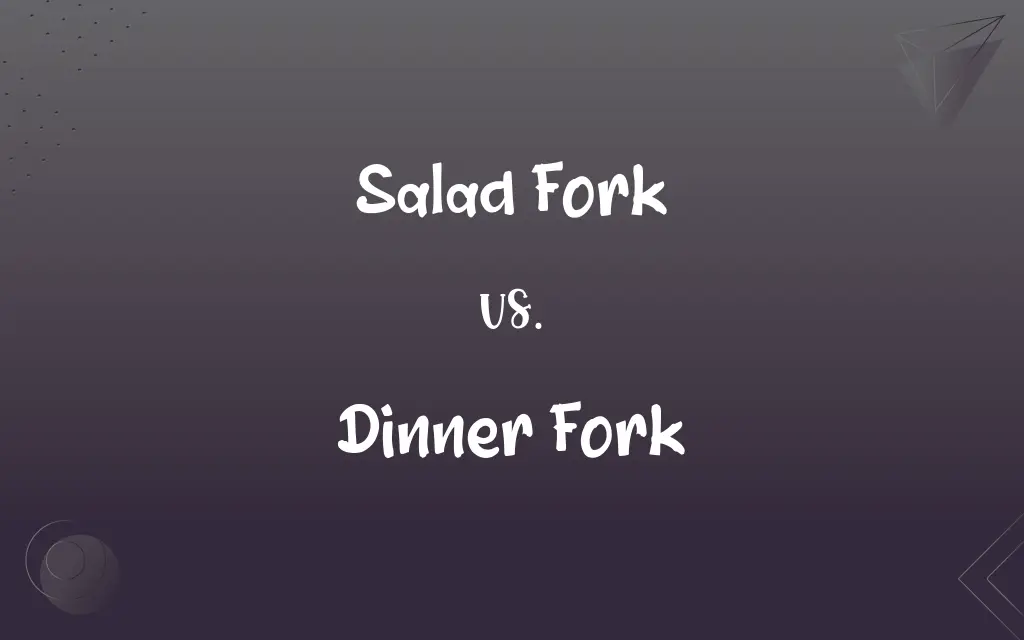Salad Fork vs. Dinner Fork: What's the Difference?
Edited by Aimie Carlson || By Harlon Moss || Updated on October 10, 2023
A salad fork is smaller and may have a wider tine while a dinner fork is larger and used for the main course. Both have specific placements in formal table settings.

Key Differences
Salad forks, typically smaller than their dinner counterparts, are utilized to enjoy appetizers, notably salads. Dinner forks, on the other hand, are reserved for main courses, designed to handle denser, often warmer meals. While the former focuses on lighter, cooler dishes, the latter tackles heartier ones, ensuring that users have an appropriate utensil for various courses.
Examining a salad fork, you’ll observe it is usually designed slightly smaller and may possess one wider tine for navigating through vegetables. Dinner forks, in contrast, maintain a uniform, larger build, aiding in cutting and conveying larger, often meatier bites. Thus, the former provides a specialized tool for leafy meals, while the latter offers a robust utility for varied main dishes.
When it comes to materials and design, salad forks often mirror the aesthetics of dinner forks, maintaining a cohesive look within a set. Nonetheless, the dinner fork typically displays a straightforward, pragmatic design suited for versatile use. The salad fork may feature subtle variations like a flatter shape or unique tine design, enhancing its functionality for its designated dish.
Historically and culturally, the salad fork symbolizes an adherence to dining etiquette, particularly in Western contexts. The dinner fork, meanwhile, boasts a universal presence, recognized across numerous culinary cultures and contexts. Thus, the salad fork speaks to a specificity in dining norms, while the dinner fork transcends boundaries, offering a ubiquitous tool for varied cuisines.
In modern dining, the salad fork, while still prevalent in formal settings, may be overlooked in casual environments. Conversely, the dinner fork remains a staple, unfazed by the casualization of dining practices. The former, though not obsolete, finds its relevance tethered to formal dining, while the latter steadfastly retains its position as a fundamental piece in both formal and informal settings.
ADVERTISEMENT
Comparison Chart
Size
Smaller, often around 6 inches
Larger, approximately 7-8 inches
Usage
Primarily for salads/appetizers
Mainly for main courses
Tine Design
May have one wider tine
Uniform tines
Placement
Left of the plate, outside
Left of the plate, inside
Prevalence in Casual Dining
Less common
Universally used
ADVERTISEMENT
Salad Fork and Dinner Fork Definitions
Salad Fork
A fork that may be presented with the salad course during formal meals.
When the salad was served, the salad fork was utilized to enjoy the dish elegantly.
Dinner Fork
A dinner fork is a fundamental eating utensil, typically used for main courses.
Martha utilized a dinner fork to gracefully navigate through her spaghetti.
Salad Fork
A dining tool generally corresponding in design with larger dinner forks.
Though smaller, the salad fork matched the design of the other utensils in the set.
Dinner Fork
A utensil with typically uniform tines designed to cut through and hold various food types.
With its straight tines, the dinner fork allowed for easy stabbing and cutting of the food items.
Salad Fork
A piece of cutlery typically placed to the far left in formal settings.
At the banquet, the salad fork was placed in the correct position for formal dining.
Dinner Fork
Typically manufactured from durable materials to manage an array of food items.
The sturdy dinner fork handled the steak effortlessly, showcasing its durable build.
Salad Fork
A utensil often possessing a broader tine for navigating vegetables.
The salad fork made spearing the cucumber slices much easier.
Dinner Fork
A larger counterpart to other specialized forks, utilized across various cuisines.
Despite the cultural diversity in meals, the dinner fork remained a consistent tool on every table.
Salad Fork
A small fork typically utilized for appetizers.
Susan grabbed a salad fork when she served herself a Caesar salad.
Dinner Fork
A frequently used utensil placed to the left of the dinner plate in table settings.
At each place setting, the dinner fork was accurately placed according to etiquette.
FAQs
How does a dinner fork differ in usage?
A dinner fork is used primarily for the main course in a meal.
Are there design variations among different dinner forks?
Yes, dinner forks can vary in design based on cultural and manufacturer differences.
Where is the salad fork placed in a table setting?
The salad fork is placed to the left of the plate, outside the dinner fork.
Can a salad fork be used for desserts?
In some settings, a salad fork might be used for dessert if a specific dessert fork is not provided.
Why are salad forks often part of a formal cutlery set?
Including a salad fork adheres to traditional Western dining etiquette for multi-course meals.
What is a salad fork typically used for?
A salad fork is used for eating salads and sometimes other appetizers.
Is a salad fork optional in informal dining?
Yes, salad forks are often reserved for formal dining settings and may be omitted informally.
Is a salad fork smaller than a dinner fork?
Yes, salad forks are generally smaller than dinner forks.
Can a dinner fork be used for salad?
While not traditional, a dinner fork can be used for salad, especially in informal settings.
Can salad forks and dinner forks be made from different materials within a set?
While possible, forks within a set are usually made from the same material for consistency.
Are dinner forks universal in design globally?
While widely used, dinner fork designs can vary slightly among different cultures and manufacturers.
Can a dinner fork and salad fork be used interchangeably?
In informal settings, they may be used interchangeably, but traditionally each has its own purpose.
Is the wider tine on salad forks found in all designs?
While common, not all salad forks feature a wider tine, as designs can vary.
Can salad forks have a specialized tine design?
Yes, salad forks often have one wider tine to help manage vegetables.
How is a dinner fork placed in a formal table setting?
The dinner fork is placed to the left of the plate, inside of the salad fork.
Is the salad fork always used for salad courses?
Traditionally, yes, but it can be used for other appetizers in certain dining contexts.
Is it considered improper to use a dinner fork for salad in formal settings?
Yes, using a dinner fork for salad might be seen as a faux pas in formal dining.
How do you care for silver dinner forks to prevent tarnishing?
Regular polishing and storing in a cutlery roll or box helps prevent tarnishing of silver dinner forks.
Can dinner forks be used in both casual and formal settings?
Yes, dinner forks are versatile and used in various dining contexts.
What material is a dinner fork typically made from?
Dinner forks are usually made from stainless steel, silver, or other durable materials.
About Author
Written by
Harlon MossHarlon is a seasoned quality moderator and accomplished content writer for Difference Wiki. An alumnus of the prestigious University of California, he earned his degree in Computer Science. Leveraging his academic background, Harlon brings a meticulous and informed perspective to his work, ensuring content accuracy and excellence.
Edited by
Aimie CarlsonAimie Carlson, holding a master's degree in English literature, is a fervent English language enthusiast. She lends her writing talents to Difference Wiki, a prominent website that specializes in comparisons, offering readers insightful analyses that both captivate and inform.































































